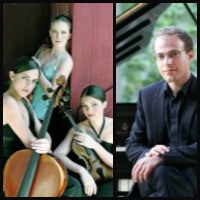by Timothy Robson

There was a certain down home feeling between the audience and the performers; three of the four have strong Cleveland connections, either through family relationships or study at the Cleveland Institute of Music. The local ties for the concert were further emphasized with some cross-organizational marketing: Richard Fried, the President of the Chamber Music Society, introduced the program and gave the usual plug for future concerts. He then introduced Diana Cohen and Frank Cohen, masterminds of the summer ChamberFest Cleveland, who spoke about the close relationship between the two organizations, as well as with the evening’s performers.
The opening String Trio in G Major, op. 9, no. 1, by Ludwig van Beethoven, demonstrated that composer’s genius in the development of small musical phrases into a masterful totality, as well as the surprisingly avant-garde harmonic excursions that he introduces. The opening movement begins with a slow introduction with each instrument playing fragmentary phrases that lead into the main, exuberant Allegro. The second movement Adagio is filled with melodic interest; however, in this performance the players did not make the most of the many lyrical phrases. The third movement Scherzo is refined and dance-like, with a graceful central “rustic” melody for the cello. The final movement is a very fast perpetual motion, again with odd, brief key changes. Although the Albers Trio’s performance was perfectly satisfactory, it did not plumb the depths of what Beethoven put on offer in his trio. The performance seemed too “polite.”
In contrast to the Beethoven, the Albers Trio’s performance of Bohuslav Martinů’s String Trio, No. 2 (1934) was riveting. Throughout the sectional two movements, the trio seemed much more involved in the drama of the music, giving an intense reading of Martinů’s astringent harmonies and off-kilter rhythms. The first movement, although marked Allegro, has an extended slow central section that features extended solos for each of the performers. After a transitional passage featuring mysterious and dramatic tremolos, the opening music returns. The second movement begins with the cello, in a slow, impassioned chant-like solo, to which the other instruments respond in a cadence resembling a liturgical “Amen.” The solo viola has a similar melodic passage, again with the “Amen” refrain. Immediately thereafter the trio launches into a concluding Allegro in which Bohemian folk music is never very far away from the melodic and harmonic mix.
Due to the inclement weather, the evening’s intermission was shortened, and pianist Orion Weiss joined the Albers Trio for a muscular performance of Antonín Dvořák’s Quartet for Piano and Strings in E-flat, op. 87. Indeed, during the raucous first movement, the piano threatened at times to engulf the string sound. The gorgeous second movement was the highlight of the concert: a solo cello melody accompanied by simple piano chords and single violin and viola pizzicato notes. It had an ethereal quality, broken briefly by a dramatic outburst. The piano takes up the solo, and the movement ends in stillness with the cello reprising the opening music.
The third movement was a waltz, with piano filigree around the edges. The central “trio” (as in the traditional classical form of minuet-trio-minuet) galloped along, with a return to the opening music, this time with some exotic eastern European harmonic twists. The polka-ish fourth movement owes much to the style of Dvořák’s 8th Symphony, op. 89, composed shortly after this trio, as well as his Slavonic Dances. This was an accomplished performance. The joyful ending brought a warm response from the audience on this cold, snowy evening.
Published on ClevelandClassical.com February 10, 2014
Click here for a printable version of this article.



